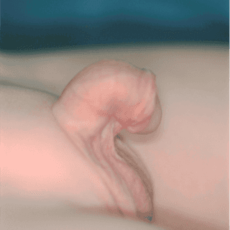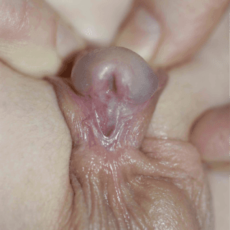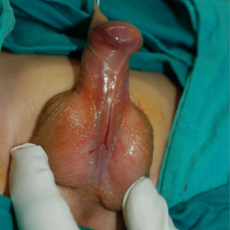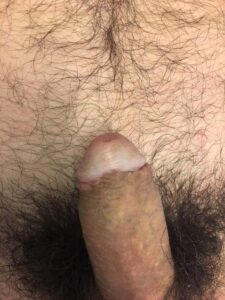What is Hypospadias

Hypospadias is a congenital malformation of male genitalia mainly characterized by an incomplete development of the urethra. There is an abnormal opening of the urethra, not at the apex of the glans but on the ventral surface of the penis. The skin of the penis (foreskin) that normally covers the glans, is absent in the ventral part of the penis and exuberant in the dorsal part. This abnormal opening of the urethra can be located at any level, along the penis or in the scrotum or perineum. Hypospadias can be associated with a curvature of the penis (congenital curvature) during erection.
The classification of the hypospadias is based on the location of the urethral meatus:
- glandular – subcoronal (distal) 50% of cases
- penis (medium) 20% of cases
- scroto-perineal (proximal) 30% of cases
The urethral meatus in an abnormal position creates various problems such as the deviation of the urinary stream, altered aesthetic appearance of the penis and genitals, psychological problems with potential repercussions on the quality of life of patients.
What is the incidence of hypospadias and associated anomalies?
Hypospadias occur in approximately 0.3% of healthy male infants. Urinary tract abnormalities in patients with hypospadias are rare because the external genitals are formed after the high urinary tract. The retained testicle and inguinal hernia are the most frequently (10% of the cases) associated pathologies associated with hypospadias. In the forms of scroto-perineal hypospadias complex anogenital malformations and chromosomal disorders may be present.
The diagnosis of hypospadias can be made already in utero, during pregnancy, with ultrasound examination of the fetus. However, diagnostic confirmation is immediate at the time of birth. The classic signs of the penis with hypospadias are the abnormal position of the urethral meatus and the presence of the typical preputial skin cap on the back of the penis.
What surgical treatment is available to treat this condition?
There are mainly 3 reasons that lead to intervention:
- Functional reason:
the meatus in an abnormal position prevents urination when standing.
If the meatus is restricted, it is not possible to urinate with repercussions at the bladder and kidney level - Sexual reason:
the possible presence of a congenital curvature of the penis will hinder the penetration of the penis into the vagina in the future.
The anomalous position of the meatus in severe forms will prevent ejaculation in the vagina and therefore the ability to fertilize the woman. - Aesthetic reason:
the aesthetic appearance of the penis could cause important psychological problems.
The surgery wants to give an answer to all three functional, sexual, aesthetic reasons:
- bring the urethral meatus to the top of the penis in its natural position and reconstruct the missing urethra
- correct the curvature of the penis
- create an aesthetic aspect similar to normality.
The most opportune time for the surgical correction of hypospadias is between the 6th and 18th month of life, when the psychological consequences of a surgical intervention are minimal.
The long-term evaluation of the results in patients undergoing hypospadias surgery is difficult and often the surgeon’s assessment of the outcome is different from that of the patient. All patients, therefore, should be followed during adolescence and should be offered the possibility of further cosmetic correction if they are not satisfied. However, with current surgical techniques, the patient born with hypospadias has a high possibility of having a normal sexual function, a normal mitto and an acceptable aesthetic result.
Complications of hypospadias
Hypospadias surgery is characterized by 10-30% complications, especially fistulas and urethral strictures, which may require further surgical repair at least 3 months after the first one.
Video Testimonial – Intervention in Belgrade
Failed hypospadias surgery
Video Testimonial – Intervention in Belgrade
Failed hypospadias with ventral curvature










